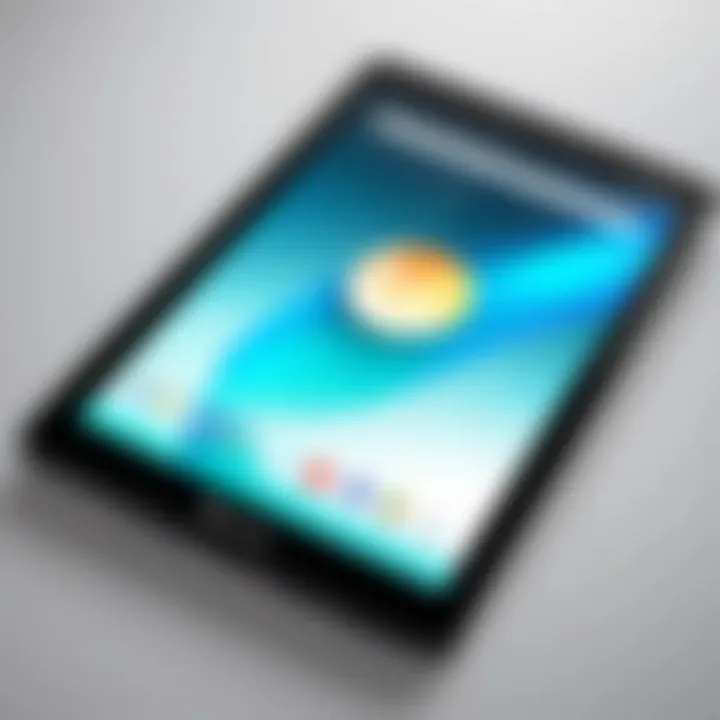Motorola's Tablet Journey: Past, Present, and Future


Intro
Motorola has carved a niche for itself in the tech landscape, partly with its phones and partially with its foray into other devices. However, its engagement with tablets isn't as widely discussed. A detailed look into Motorola's tablet offerings reveals not only its historical context but also current products and the potential avenues for the future. This examination will lay bare the notable features, competitive positioning, and the evolving landscape of consumer preferences that drive Motorola's tablet strategies.
Understanding the importance of this discussion is essential, especially for tech enthusiasts, gamers, and builders who are always looking for the next best thing in mobility.
Overview of the Product
Purpose and Benefits
Motorola tablets aim to blend functionality with user-friendly experiences. Whether for work, play, or education, these tablets are engineered to meet various user needs. From seamless multitasking capabilities to entertainment-rich features, their purpose is multi-faceted. They cater well to individuals who seek portability without compromising performance.
The advantages of using Motorola tablets include:
- User-friendly interface: Intuitive software that doesn’t require a tech degree to navigate.
- Versatile applications: Designed for apps ranging from productivity tools to games.
- Exceptional build quality: Known for their durability and premium feel, making them a solid choice for everyday use.
Target Audience
Motorola specifically targets young professionals and educational institutions, creating devices that are accessible yet powerful. Gamers too find value here; the emphasis on performance resonates well with those who want smooth graphics and speedy load times.
Key Features
Some of the leading features that stand out in Motorola’s tablet line include:
- High-resolution displays: Allowing for vivid color reproduction and detailed imagery.
- Extended battery life: Ensures all-day usage, making it perfect for on-the-go lifestyles.
- Expandable storage options: Catering to those who require more space for apps and media.
Technical Specifications
Detailed Product Specs
Motorola tablets come packed with specifications tailored for various demands. This typically includes various display sizes, processor options, and connectivity features. For example, the recent Motorola Tab G20 sports a 10.1-inch display, MediaTek Helio P22T chip, and runs on Android 11.
CPU Characteristics
The processors, often MediaTek or Qualcomm Snapdragon, significantly influence performance. With octa-core options in many models, users can expect smooth operation whether streaming or gaming.
GPU Features
Integrated GPUs are optimized for mobile use, enhancing visual experiences across the board. Utilizing technologies like Adreno or Mali, these tablets can handle graphics-heavy applications effectively.
Memory Details
Motorola tablets typically feature varied RAM options. It's common to see choices between 3GB and 4GB, catering well for multitasking users.
Performance Benchmarks
Real-world use shows that these tablets can handle up to several applications running simultaneously without lag. Benchmarks from independent reviewers often put them in the same league as competitors at similar price points.
Comparison with Similar Products
Market Competitors
In the tablet market, competition is stiff. Brands like Samsung, Apple, and Lenovo frequently dominate discussions about the best devices. However, Motorola’s unique offerings position them as budget-friendly alternatives.
Comparative Analysis
When comparing Motorola tablets with higher-priced competitors, the value becomes apparent. While brands like Apple feature premium hardware, Motorola provides a fellow user-experience without the hefty price tag. This balance can be a deciding factor for consumers.
Best Use Cases
Motorola tablets excel in various scenarios:
- Education: Ideal for students needing reliable performance for online classes.
- Entertainment: Great for binge-watching content due to their sleek designs and audio capabilities.
- Work: Equipped with productivity apps, they serve professionals well for presentations and document handling.
Commonly Asked Questionss and Troubleshooting
Common Issues and Solutions
Some common frustrations reported by users include slower performance over time or connectivity issues. However, most concerns can be resolved with simple software updates or by clearing caches.
Expert Tips


- Always keep your device updated: This can fix performance bugs and security vulnerabilities.
- Use a reputable app store: To avoid downloading malware, stick to familiar platforms.
Intro to Motorola and Tablets
In the current tech-savvy world, tablets are more than just fancy gadgets; they serve as tools for productivity, creativity, and entertainment. This article casts a spotlight on Motorola's engagement with the tablet market, a realm where it's often overshadowed by giants like Apple and Samsung. Understanding Motorola's journey in this landscape isn’t just about the devices they released, but it's also tied to their innovative spirit and strategic maneuvers. Each model tells a story of ambition, technological progress, and consumer insights.
Overview of Motorola
Motorola has well-established itself as a pivotal player in the mobile technology sector. Founded in the late 1920s, the company began with the production of radio equipment but later transformed the communications industry with the advent of the mobile phone. Their ability to pivot in accordance with market demands speaks to their resilience. With a rich history that includes groundbreaking products, Motorola's brand is steeped in innovation and quality. From their early days of the flip phone to their latest smartphone offerings, Motorola has remained committed to shaping user experiences, leveraging tech advances to meet evolving consumer needs.
Tablet Market Context
The tablet market, characterized by its rapid evolution, has witnessed a fascinating convergence of various technologies. In the early days, tablets were often perceived as oversized phones without calling capabilities. However, they quickly grew into essential devices catering to diverse functionalities, from media consumption to professional work. Factors like portability, larger display sizes, and versatile operating systems have made tablets a staple in both homes and workplaces.
Motorola's foray into this market comes at a time when the competition is fierce. Manufacturers continually strive to unveil features that delight users, whether through cutting-edge displays, longer battery life, or enhanced processing power. Amidst this backdrop, understanding the role of Motorola becomes crucial. Could they carve out their niche, or would they remain a footnote in history? The upcoming sections dive deeper into their tablet history, aligning product developments with marketplace trends.
Motorola's History with Tablets
When diving into the world of tablets, it’s hard to overlook Motorola's history with these devices. The company has not only been a key player in the telecom industry but also played a significant role in shaping the tablet landscape. By examining the past, one can discern trends and influences that have led to Motorola’s current position in the market. It's not just about counting the number of models they released; it’s about the lessons learned and the innovations that emerged from their experience.
Motorola stands out because it approached the tablet market with the kind of boldness that many might find lacking today. Their decisions weren't just tactical; they sought to offer something that could transcend mere functionality and resonate with users' needs.
Early Ventures into Tablets
Motorola's first forays into tablets were nothing short of ambitious. The company ventured into the tablet space during a time when the market was relatively undeveloped. The Motorola XOOM, launched in 2011, was notably one of their early relevant launches. At that time, with the tablet market barely in its infancy, it aimed to harness the potential of a touch-friendly interface paired with Android. This marked a step towards solidifying Motorola's place in a burgeoning tablet landscape.
Early efforts like XOOM weren't just tests on the waters; they were vital learning experiences. Failure and success alike shaped Motorola's roadmap. They began to understand consumer preferences, the importance of apps, and how design plays an essential part in user satisfaction.
Key Models Launched
Motorola XOOM
The Motorola XOOM stands as a landmark in Motorola's tablet history. It was among the first tablets to run Android 3.0 Honeycomb, a version specifically designed for larger screens. What set the XOOM apart was its 10.1-inch display and the capability to later upgrade to Android 4.0 Ice Cream Sandwich, which was a significant selling point at the time.
Motorola XOOM also introduced features like a dual-core processor, front and rear cameras, and support for Adobe Flash, making it quite versatile for multimedia uses. However, while some users praised its robust features, others found its weight cumbersome for prolonged use.
Its launch highlighted Motorola's commitment to innovation, even if it didn't fully capture market share from competitors like Apple's iPad. Ultimately, the XOOM laid foundational knowledge about the importance of user interface and ecosystem integration for Motorola's subsequent models.
Motorola Droid XYBoard
Following the XOOM, Motorola introduced the Droid XYBoard in late 2011. This tablet emphasized portability and style. Available in 8.2 and 10.1 inches, it targeted users looking for a good balance between screen real estate and ease of use on the go.
What made the Droid XYBoard appealing was its sleek design coupled with solid specifications. It utilized the capabilities of Android and was marketed rightly as a successor to the XOOM, boasting improved processing power and better battery life.
Nevertheless, some reviews critiqued the XYBoard for its relatively high price point, which made it less competitive against options from rival brands. It was a learning curve for Motorola regarding price positioning in a highly competitive market.
Market Performance and Challenges
The journey of Motorola in the tablet market has been a rollercoaster of ups and downs. One key challenge has been maintaining visibility among tech enthusiasts amidst rapidly evolving tech trends. Despite launching quality products, they often faced stiff competition from big names like Apple and Samsung.
In assessing their market performance, one can notice their strength in creating unique models. However, they often struggled with marketing strategies and brand recognition, which affected their overall penetration in the market.
By analyzing these performances, it is clear that Motorola's history with tablets is not merely a sequence of product launches; rather, it's an ongoing story that informs the brand's present and future endeavors.
Current Portfolio of Motorola Tablets
Motorola's current portfolio of tablets is a window into its evolving strategy and adaptation to market trends. It showcases how a brand, known primarily for smartphones, has diversified into the realm of tablets. The significance of this section lies in understanding how Motorola positions itself amid stiff competition and ever-changing consumer demands. Each model in their lineup speaks to a blend of usability, affordability, and unique features tailored for different user needs. By examining these offerings, we glean insights into Motorola’s ongoing narrative in the tablet ecosystem.
Latest Tablet Models
Motorola has several tablet models that cater to various segments of the market. For instance, the Motorola Tab G20, with its sleek design and user-friendly interface, is aimed at budget-conscious consumers. Its lightweight nature makes it an ideal travel companion, allowing users to browse, watch, and engage with content seamlessly. Another notable mention is the Motorola Tab P11 Plus, which elevates the experience with stylish aesthetics, a vibrant display, and performance catered to both work and leisure. This model, particularly, seems to strike a balance between affordability and functionality, appealing to users who might not need top-tier specifications but desire a dependable tablet for everyday tasks.
Technical Specifications Reviewed
Display Characteristics
Motorola's tablet lineup offers varied display options that cater to different consumer preferences. Models like the Tab P11 Plus feature an 11-inch LCD panel that boasts a resolution of 2000 x 1200 pixels. This feature is not just for show; it enhances the viewing experience by providing sharp images and vivid colors.
The key characteristic of this display is its color accuracy and brightness, making it a popular choice for streaming videos and even light productivity work. The screen's added benefit of low blue light emission also promotes comfortable viewing over prolonged periods, thus reducing strain on users' eyes. A potential downside, however, could be its performance in bright sunlight, where reflections may hinder visibility.
Processing Power


In terms of processing power, Motorola's tablets, like the previously mentioned Tab G20, utilize octa-core processors which ensure a smooth performance for daily tasks, including browsing and streaming. The efficient chipsets enable multitasking capabilities, allowing users to switch between applications without a hitch.
The main advantage here lies in the balance of performance and battery life, allowing users to enjoy extended usage without frequent recharging. However, anyone looking for raw, gaming-grade power may find limits with devices like the Tab G20, as it might not handle intensive tasks such as high-end gaming or heavy editing smoothly.
Target Markets and Consumer Demographics
Motorola's tablet offerings seem tailored to a broad demographic, from students to busy professionals. The introduction of models like the Tab G20 targets entry-level users who value simplicity and practicality. At the same time, the more advanced Tab P11 Plus aims at tech-savvy individuals seeking dependable performance and enhanced visual experiences.
Motorola effectively segments its audience by combining affordability with essential features, consequently carving a niche amidst competitors like Apple and Samsung. This stratified approach allows the company to attract diverse consumers and expand its footprint in the tablet space.
"In an industry where innovation is key, it's vital for brands to stay relevant. Motorola is careful not to overlook consumer demands across different price points, ensuring their tablet offerings appeal to a broader audience."
Through the analysis of its current tablet portfolio, it's clear that Motorola aims to provide a range of options that meet varied user needs. This positions them as a significant player in the tablet market, especially among consumers seeking value and functionality in their devices.
Unique Features of Motorola Tablets
When talking about Motorola's tablet offerings, the unique features stand out as vital elements that can differentiate them from rivals in the crowded tablet market. These elements not only define the user experience but also reflect Motorola's adaptation to meet consumer demands. Exploring these unique aspects helps underline the advantages that Motorola tablets present, not merely as devices but as tools tailored to varying consumer needs.
Design and Build Quality
Motorola tablets come with a design that balances aesthetic appeal with practical usability. The materials used often enhance the device's durability without compromising style. For instance, some models feature a sleek aluminum chassis, making it robust yet lightweight. This particular combination is important because a sturdy build speaks to the tablet's longevity and its suitability for both heavy usage and portability.
Moreover, the ergonomic design of Motorola tablets makes them comfortable for extended use—whether it’s reading a book, watching movies, or scrolling through social media. These tablets often sport thinner bezels and a pleasant grip, contributing to a seamless user experience. When users consider a tablet, the first impression often comes from how it looks and feels in hand, and Motorola manages to deliver a solid option on both fronts.
Software and User Interface
A tablet is only as good as its software, and Motorola's decision to stick closely with stock Android contributes positively to the user experience.
Android Versions
The implementation of Android versions in Motorola tablets typically assures users that they are getting a cleaner and faster interface. This adherence to close-to-stock Android eliminates unnecessary bloatware, making the system faster and more fluid. One of the main advantages here is that users often appreciate a seamless, intuitive interaction with their devices. Updates for Android systems are frequently rolled out in a timely manner, meaning users frequently benefit from enhanced security and new features.
An interesting aspect to note is the significant update support Motorola offers with Android versions compared to some competitors. This factor makes Motorola an appealing choice for tech-savvy users who value longevity in updates and features.
Custom ROMs
For enthusiasts who like to tinker, the possibility of using Custom ROMs on Motorola tablets is another compelling reason to consider these devices. A key characteristic of Custom ROMs is the ability to provide options beyond the stock Android experience. Custom setups can offer improved battery life, additional features, or simply a more personalized user interface. For many users, this flexibility can amplify their experience with the device.
However, there are downsides to consider. Running a Custom ROM can lead to stability issues or voiding warranties, which some users might find concerning. Still, for those who enjoy customizing their devices, the ability to change and enhance the operating environment is a notable advantage of Motorola’s offerings.
Accessories and Ecosystem
The expanded functionality that accessories bring to Motorola tablets truly enhances their appeal. With the right accessories, these tablets can transform from casual devices into more powerful productivity tools.
Keyboard Attachments
Keyboard attachments for Motorola tablets are not just convenient; they also increase productivity. Using such accessories can make typing long emails or documents far more manageable. The tactile feedback many users experience with these keyboard attachments can mimic a laptop experience, which is a critical consideration for professionals on the go.
Moreover, many of these attachments come with integrated features such as additional battery life or connectivity options, extending the usability of the tablet. Nevertheless, there is some concern around the added bulk they can bring, which might deter users who prefer maintaining the tablet's slim profile.
Stylus Compatibility
Stylus compatibility in Motorola tablets is another unique feature that sets them apart. This tool is particularly beneficial for artists, designers, or anyone who finds themselves taking handwritten notes frequently. The precision that a stylus provides can enhance creativity and improve productivity significantly.
However, the stylus often comes at an additional cost, and while many users find it worth the investment, it can be considered a limitation for those who look for a complete package without any extra purchases.
In summation, the unique features found in Motorola tablets—ranging from their design to software and accessories—are carefully designed to cater to a variety of users, from casual consumers to tech enthusiasts. Each aspect contributes to a well-rounded user experience that can make a difference in how the tablet fits into real-world applications.
Competitive Landscape of Tablets
Understanding the competitive landscape of tablets is crucial for evaluating Motorola's position and strategy within the tech ecosystem. The tablet market is not just a simple arena for product sales; it's a complex battleground where brands constantly innovate and adjust based on consumer preferences and technological advancements. Examining how Motorola stacks up against its competitors allows buyers, tech enthusiasts, and industry observers to grasp the nuances of each brand's approach, innovations, and market dynamics.
Comparative Analysis with Major Rivals
Apple's iPad
The Apple iPad stands as a towering figure in the tablet domain. Notably, its reliance on a robust operating system called iPadOS evolves with regular updates, ensuring users have access to the latest features and security enhancements. What sets the iPad apart is its seamless ecosystem that ties together various Apple devices, giving it an edge in user loyalty and brand recognition.
When it comes to design, the iPad boasts sleek lines and a premium finish, so it’s not just a device; it’s a statement. The Retina Display is a hallmark of the iPad, providing vibrant colors and sharp images, which are appealing for everything from gaming to professional work. However, with its high price point, many users might feel the pinch. Still, those who opt for the iPad often find its longevity in performance offsets the initial investment. This level of consistency in software and hardware is often cited as a key characteristic contributing to its popularity among consumers.
A unique aspect of the iPad is its Apple Pencil compatibility which enhances productivity and creativity. This feature is a favored advantage for artists and note-takers alike, although critics argue that the accessory itself is quite pricey, which might deter some potential users.


Samsung's Galaxy Tab
In contrast, the Samsung Galaxy Tab presents a different flavor of tablet experience. Excelling in display technology, Samsung utilizes its Super AMOLED screens that provide deep blacks and vivid colors. This characteristic makes it highly regarded among media consumers who desire the best viewing experiences when streaming videos or playing games.
Samsung tablets are powered by Android, which provides a range of customization options that many users appreciate. This flexibility allows for a more tailored experience compared to what Apple's ecosystem offers. What's more, Samsung’s DeX feature transforms the tablet into a pseudo-desktop experience, which is appealing for those who work on the go.
Yet, the uniqueness of the Galaxy Tab may come with a few drawbacks. Certain models can face software update delays compared to the more consistently updated iPads. While this may not be a deal-breaker for everyone, it is a consideration worth noting for tech enthusiasts wanting the latest features without delay.
Market Share Insights
Examining market share gives a clearer picture of how Motorola fits into the bigger tableau of the tablet industry. The landscape shows fierce competition, with Apple and Samsung leading the way. According to various studies, Apple's iPads hold a commanding 50% of the tablet market share, while Samsung commands around 20%.
Motorola has struggled to establish a significant foothold, often relegated to niche markets or mid-range options. Factors like aggressive pricing strategies, targeted advertising campaigns, and unique product features are vital considerations for Motorola as they look to carve out a more substantial presence in this crowded field. Ultimately, consumers seeking value and functionality have various options available, and understanding the competitive landscape allows them to make informed choices.
"The tablet market is like a chess game; every move counts, and knowing your opponent makes all the difference."
As we continue to analyze how Motorola can adapt its offerings to better compete with industry giants, these insights serve as a critical foundation for understanding their path forward.
Consumer Feedback on Motorola Tablets
Analyzing consumer feedback on Motorola tablets opens the door to understanding how the products are perceived in a competitive market. It’s not only about what features Motorola boasts; it’s about what users genuinely think after having used the devices. This crucial perspective informs potential buyers and can highlight strengths or weaknesses that might not be on display in marketing materials. Feedback typically reveals insights into user satisfaction, comfort, and overall performance. Understanding this element is key, as it can influence purchasing decisions and shape future iterations of the tablets.
Review Analysis from Users
When we examine user reviews, a mixed bag often emerges. Many users appreciate the overall solid build quality. Here are a few recurring themes from the feedback:
- Performance: Users often rave about the processing speed in most models, especially in multitasking scenarios. The Motorola tablets seem to handle various applications concurrently with grace, easing concerns around lag or slowdown—an important aspect for gamers and tech aficionados alike.
- Display Quality: Many reviews praise the vivid displays, which pop with color and are great for media consumption. This stands out particularly in bright settings, where other tablets might struggle.
- Battery Life: Battery performance tends to be a point of contention. While some users report days of extended use, others express frustration over rapid battery drain during intense gaming or video streaming.
- Software Experience: The Android interface facilitates an intuitive user experience for most, but some note a cluttered feel due to pre-installed apps. Simplifying bloatware could enhance usability dramatically, according to several reviewers.
In summary, user reviews provide a window into real-life experiences, highlighting both triumphs and areas for growth in Motorola’s tablet offerings.
Addressing Common Critique Points
While user reviews reveal a lot of positive feedback, common critique points can’t be ignored. Addressing these issues not only provides transparency but also illustrates Motorola's responsiveness to consumer needs. Here are some frequently mentioned complaints:
- Weight and Portability: Some users find Motorola tablets on the heavier side, making prolonged usage uncomfortable. This feedback leads to questions about design prioritization and could motivate future models to focus on lightweight materials without sacrificing durability.
- Customer Support: Another recurring theme is dissatisfaction with customer service. Customers report lengthy response times and an overall feeling of being overlooked. This aspect can greatly influence brand loyalty and may need addressing for enhanced customer satisfaction.
- Updates and Longevity: Many tech enthusiasts express concern about the updates provided for software. A few users noted lagging behind competitors regarding timely software enhancements that can hinder the user experience over time. Regular updates could solidify Motorola's reputation in the tablet market.
"Consumer feedback is everything; it shapes not only future products but also brand perception. If Motorola wants to thrive, listening to their customers is key!"
Future Prospects for Motorola in the Tablet Space
As we look toward the future, Motorola's ambitions in the tablet arena merit closer scrutiny. The brand's endeavors are not just about keeping pace with trends; they echo a broader strategy aimed at optimizing their market share. With an intuitive understanding of consumer preferences and emerging technological innovations, Motorola stands at a crossroads, poised for potential growth.
One of the key elements to consider in the evolution of Motorola tablets is adaptability in design and functionality. The digital landscape is shifting, with increasing demands for versatility in devices. Tablets that can seamlessly transition from productivity tools to entertainment hubs are likely to catch consumer interest. This is where Motorola can leverage its legacy in innovation. A model aiming for multi-functionality can attract both professionals seeking efficiency, and families craving entertainment.
Moreover, we can’t ignore the role of sustainability in future products. More consumers are becoming eco-conscious, wanting to support brands that prioritize environmental responsibility. Motorola’s future endeavors could include using recycled materials or integrating energy-efficient technologies. This could place them favorably among consumers who place importance on ethical consumption.
"In an era where technology must align with values, sticking to old habits may spell disaster for brands."
Predictions Based on Market Trends
The outlook for Motorola in the tablet market is intricately linked to prevailing market trends. Current behaviors shine a light on several key predictions:
- Increased Mobile Work: The rise of remote work has changed how tablets are perceived. They're no longer merely consumption devices; people are using them for work-centric tasks. Motorola might explore offering advanced productivity features and accessories that cater to professionals.
- Content Creation Features: The surge in social media and content creation signifies that tablets should enable artistic expression. Enhanced camera functionalities, stylus support for sketching, and robust editing software could elevate Motorola's offerings.
- Competitive Price Points: As competition from brands like Samsung and Apple stiffens, Motorola may adopt a price strategy that appeals to budget-conscious consumers while still delivering high-value features.
Potential Collaborations and Partnerships
Strategic alliances could pave the way for Motorola's revival in the tablet segment. Here’s how:
- Software Partnerships: Collaborating with developers of productivity software like Microsoft or Adobe may enrich the user experience on Motorola devices, making them more appealing to professionals.
- Ecosystem Creation: Establishing partnerships with accessory manufacturers can enhance the overall ecosystem of Motorola tablets. Such collaborations might include customized cases or specialized keyboards that are not just functional but optimized for performance.
- Telecom Collaborations: Engaging with major telecom companies to integrate their tablets into data plans can be beneficial. Bundling devices with service contracts may help boost sales and allow consumers to easily access Motorola's tablets.
Epilogue and Final Thoughts
As we step back to assess everything discussed about Motorola's tablet offerings, it's clear that the trajectory of their journey in this space is both intriguing and insightful. The brand's history gives us a lens through which we can evaluate their current position and speculate about future initiatives.
Summary of Findings
Throughout the analysis, we've come across several key points regarding Motorola's approach to tablets:
- Historical Engagement: Motorola made significant strides early on with products like the Motorola XOOM, showcasing a willingness to innovate within the tablet landscape.
- Current Offerings: Their latest models reveal an intention to cater to diverse user needs, balancing performance with affordability.
- Consumer Insights: User feedback has honed in on aspects such as design and user interface, illustrating where Motorola excels and where improvements are sought.
- Satellite Market Position: While competing against giants like Apple and Samsung, Motorola's unique value proposition rests in its ecosystems and customer engagement strategies—defining its niche within the broader market.
This ensemble of findings paints a picture of a resilient company willing to adapt and strategize within a crowded market.
Implications for Consumers and Tech Enthusiasts
For consumers and tech enthusiasts, understanding Motorola's tablet offerings not only provides insight into the devices themselves but also hints at trends in the industry.
- Choice Diversification: Users now have a more varied selection, allowing them to find tablets that fit specific needs—be it for gaming, productivity, or casual use.
- Price versus Performance: With solid performances at competitive prices, Motorola's tablets can be appealing choices for those who prioritize value without compromising on essential features.
- Community Insights: Engaging with community feedback can empower users, enabling them to make informed choices based on real-world experiences shared in places like Reddit.
In essence, Motorola's evolution speaks volumes about the dynamic nature of tech markets. It shows that both savvy shoppers and hobbyists can benefit from keeping a close eye on such developments, as they often herald changes that can profoundly affect future purchasing decisions.



